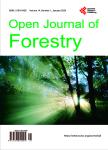Analysis of the Spatio-Temporal Dynamics of Land Use in the Bamboutos Mountains of the West Region of Cameroon
Analysis of the Spatio-Temporal Dynamics of Land Use in the Bamboutos Mountains of the West Region of Cameroon作者机构:Department of Forestry Faculty of Agronomy and Agricultural Sciences University of Dschang Dschang Cameroon Department of Geography Faculty of Arts Letters and Humanities University of Yaoundé 1 Yaoundé Cameroon
出 版 物:《Open Journal of Forestry》 (林学期刊(英文))
年 卷 期:2022年第12卷第2期
页 面:216-234页
学科分类:070801[理学-固体地球物理学] 07[理学] 08[工学] 0708[理学-地球物理学] 0816[工学-测绘科学与技术]
主 题:Bamboutos Mountains GIS Mapping Degradation Landscape Restoration
摘 要:The current level of knowledge of the biophysical situation, human activity and governance in the Bamboutos Mountains does not shed enough light on the dynamics of the vegetation, the socio-economic aspects and ecological opportunities that are essential for a successful restoration initiative in this degraded landscape of the Bamboutos mountain ecosystems. The objective of the study was to map and analyze the dynamics of land use from Landsat images of 1980, 2000 and 2021. Supervised classification by maximum likelihood was applied and the dynamics were analyzed using area curves and calculations. The cartographic results were used to produce land use maps. The analysis of the land cover dynamics shows that the evolutionary trend of the vegetation formations is essentially regressive for agro-forests and dense forests at -21.20% and -3.62% respectively. The classes that showed a clear progression were bare soil (9.78%), crop land (8.03%), built-up areas (5.19%) and shrubby savannahs and grassland (1.84%). Agriculture, livestock grazing and demographic pressure are the main causes of land degradation and mutation of the landscape. The results of this study provide an understanding of the land-use history of this landscape, and a solid basis for planning a restoration initiative. They provide guidance on priority areas and types of restoration intervention from a social, economic and ecological perspective.



